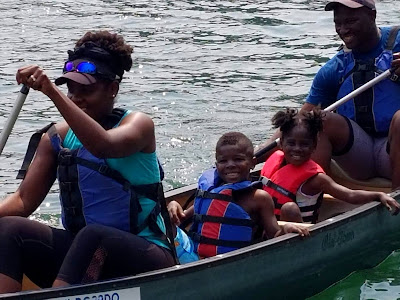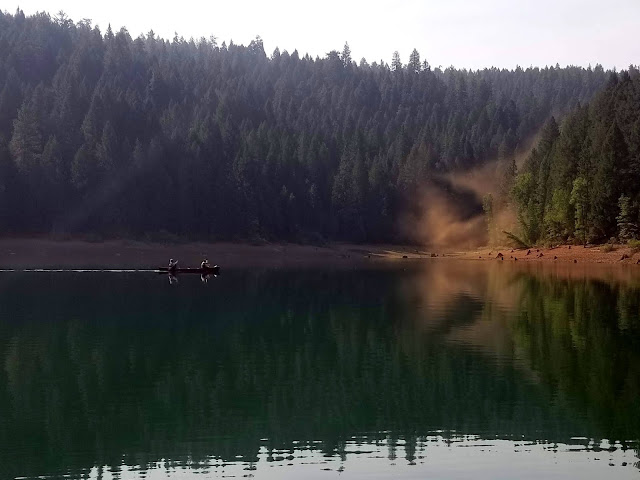Most of us picture paddling out in the heart of nature. It is easy to see ourselves gliding along on a serene mountain lake or into the bays of a country lake. For the more adventuresome, maybe running a scenic wild river or out in the ocean against a rugged coastline is more your style. But as more and more people take up paddling, an urban kayaking trend is emerging. Paddlers from coast to coast say paddling along their urban waterway has changed their perspective of their neighborhood river and the city along its banks. Switching to panoramic views of skyscrapers, bridges, and other urban dwellings instead of mountains or forest scenes offer paddlers an alternate aspect of their town often not seen.
"We love urban kayaking and it was fun to see the Minneapolis skyline from the water," wrote Minnesota based blogger Jenna Kvidt in Wander The Map! while paddling through on the Mississippi through the heart of the Twin Cities, "It’s a perspective of the city we had yet to witness, plus getting out on the water is always a great time."
Once New York paddler Noriko Okaya got over her fears of paddling New York City's Hudson River, she wrote there was no better way to see the city.
"Just over the horizon the Hudson offers magnificent views of the Manhattan skyline and a unique view of some of the most iconic man-made landmarks of the world, including the Empire State, Chrysler, the Standard, Whitney Museum, and One World Trade Center," wrote Okaya in PaddleXaminer, " Not many people get to see the city the way we do from the water, and in my opinion, it’s the best way to see New York."
While Jennifer Koerner, who is with Up the Creek Expeditions based in Jacksonville, Fla., found beauty at every turn while touring the St. Mary's River.
"At first, I couldn't imagine why someone would want to paddle by buildings and bridges. But look at the railroad trestle up. It looks like art to me," Koerner told First Coast News.
After sliding my kayak into the Lower American River at the Rossmoor Bar Access in Rancho Cordova, Ca., just east of Sacramento, I said to my paddling partner John Taylor, "How lucky we are to have this river right in our own backyard just minutes from my home."
Taylor is a veteran of many voyages down the American says no trip has ever been the same.
"I'll see something different every time," John said.
The Lower American River meanders through a network of highways, suburban streets, and urban bustle for 23 miles immediately after leaving Lake Natoma and Nimbus Dam, all the way to the confluence with the Sacramento River. At least that is what the map says, but on the river, we are in a different world.
The American River Parkway is a looping green ribbon that shelters the river and its shore for most of the way to the Sacramento River. Often called "the jewel” of the Sacramento Region, the river is the central focus of the Parkway, which features a good-mix of fast-moving currents, along with some slow and lazy flows that are perfect for most beginning paddlers. Annually more than 5 million visitors use the Parkway, not for paddling, but hiking and biking also.
It was a late summer trip for us. Past the season when a large rafting crowd frequent the river in large yellow or blue rafts with full coolers and no paddles. Popular on the hottest days of the summer, the river turns into a jamboree of hijinks, loud music, and bad sunburns. During a mid-summer trip where I took two groups down the river on the same day, I told them that the morning group would see nature, while the afternoon group would see "wildlife."
We put in on the river below San Juan Rapids with two other paddlers, skipping the sometimes tricky rapid. We still have a long way to go with an estimated 17 miles to the confluence with the Sacramento River. There is a bright blue sky, a slight breeze, a relaxing flow, and no sign of anyone outside of a few fishermen.
Classified as a “Recreation” river within the State and Federal Wild and Scenic River Systems, it was a little hard to imagine we were surrounded by the city. Since being established, the American River Parkway has ensure the preservation of the river's naturalistic environment.
"With the American River at my feet," wrote David Dawson, in the American River Parkway Foundation newsletter Stories from the Parkway, "I saw nothing of the two million human beings who surrounded me in the Sacramento metropolitan area. I saw no streets, no cars, no buildings, and no lights."
Varieties of animal wildlife such as wild turkey, deer, and hawks can be seen at every bend, while river otters and beaver wait till twilight. We saw a few deer passing over a few fast ripples near Ancil Hoffman Park. As the river turns to the south leading up River Bend Park, we paddle past a row of river homes and under the Harold Richey Bicycle Bridge, to signify that we are not that far from civilization.
The river speeds up down to Harrington Access as we encountered Arden Rapids. It is not as challenging as the San Juan Rapids as the river pushes against gravel deposits creating some standing waves.
"Go right down the middle," John tells the others.
It's a rubber raft graveyard as we encounter sunken trees and shredded rafts along the way. On a summer trip, we watched the Fire Department rescue some rafters stuck in the snag of trees.
Islands and channels provide jungle-like exploring opportunities along the way, But now it was time to paddle because the current had slowed. We heard the roar of city traffic at the Watt and Howe Avenue bridges. While cruising past the monolithic-looking structure of Sacramento's' Water treatment plant, we saw the Guy West Bridge suspension bridge. Designed to resemble the Golden Gate Bridge in San Francisco, it is used by bicyclists and pedestrians to get to the Sacramento State University campus. From now on, the closer we will come to the Sacramento River the more bridges we will encounter.
Like most urban areas, Sacramento is plagued with a growing homeless population. We paddle past scores of tents, tarps, and encampments line the river shore along with shopping carts, abandoned bicycles, and piles of trash. It is illegal to camp along the American River Parkway, but efforts to rousted the homeless from the riverway have been limited since for most, there is nowhere else for them to go.
I told John, "As much as I love this river, this is a terrible existence for them. How stressful and dangerous their lives must be. My heart goes out to them.
A train horn bellowed from above on railroad trestle as we come up to Sutter's Landing. Like all river towns, Sacramento history intertwines with the river. Captain John A. Sutter established a permanent camp and later built his fort south of the river. There is not much evidence from the past here as the dirt used to construct levees were built to elevate the city to prevent flooding leaving behind open pits. It became the city landfill for number years. Now through restoration, it is a popular park along the Parkway.
As we continued downstream, the pace slows considerably. We might have been in a hurry to get to the Sacramento River and Discovery park but, the Lower American River was not. It's deep and wide now. The ripples are gone and the river appears idle. Our kayaks were tugged along lazily like Huck Finn on the Mississippi. We paddled by two railroad bridges, one with its supports spray-painted with graffiti and was a former railroad bridge now reserved for bikes and pedestrians.
We are in the heart of the city now, except it still seems wild. Here the river is cradled by trees, obscuring any urban buildings from view. Only the I-5 bridge and a few motorboats let us know our journey is almost finished.In the distance, a jet ski and rider revs up and heads out on the Sacramento River just past the Jibboom Bridge, a historic metal truss dinosaur of a bridge built-in 1931. A swing bridge from days gone by, it now has only light traffic in its park setting. It is the last bridge we pass under during our paddle down the American River.
The Sacramento River was a dingy pale brown compared to the American River and its clear flows as we crossover into its murky water turned up by powerboats. We look to the south and finally see the city of Sacramento and its tall high-rise buildings and waterfront.
While we had to wait till the very end of our great urban adventure down the American River to see the skyscrapers of Sacramento, our trip still gave us all a new perspective of our city and its waterway.
And no matter how many times I will paddle The Lower American River as John says, it will always be a new and different experience every time, especially when I see it over the bow of your kayak.











































